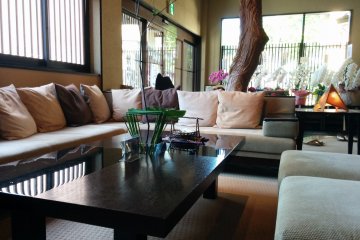Shirabu Hot Springs (or Shirabu Onsen) is a hot spring town located at the base of Mount Nishiazuma, south of Yonezawa in Yamagata Prefecture. During the Edo Period, it was one of the three Ouusantakayu, which were three areas discovered during the early part of the 14th century and considered a hot spring health resort.
Now the once flourishing hot spring town has fallen out of popularity and hotels and guest houses have gone out of business because of this. However, for those who love hot springs, they can enjoy a lesser known hot spring town with buildings and amenities that still hold traces of the past.
In the year 2000, there was a fire in the Shirabu Hot Springs area. Of the three famous ryokans (guest houses) of Nishiya, Nakaya and Higashiya (which can be translated into "West Inn," "Middle Inn," and "East Inn" respectively), Nakaya and Higashiya burned down. Although Higashiya has been rebuilt since then, Nakaya is the only remaining ryokan with an original thatched roof.
So, what is the history behind "Shirabu" (meaning "white blanket")? According to legend, it was named after a white-speckled hawk that was seen soaking in the hot spring when it was first discovered, giving the hot spring its original name of "Shirabuchi Takayu" meaning "White-Flecked Hawk Spring." There is also speculation it was named Shirabu because the hot springs looks as if it is covered in a white blanket during the winter. One other legend is that the Ainu word for "Shirabu" meant white frost, but was later give different Chinese characters to keep the same pronunciation, but change the meaning of the name.
The Ainu were people indigenous to the northern part of Japan., and considering the Ainu word came first, the name was probably embellished upon by changing the characters from meaning "white frost" to "White-Flecked Hawk" in order to give birth to that legend. In other words, regardless of how its name came about, Shirabu Hot Springs has 700 years worth of history behind it.
On this trip, I visited Higashiya Ryokan. The bathing area was small. To the right of the entrance was a bath only big enough for one person. On the left side was another small bath. In the center were three pipes of water to cascade down over you while also filling up the bath. The water itself was crystal clear. There was a slight smell of hydrogen sulfide, but not enough to really take notice of it.
In addition to the indoor bath, there was also an outdoor bath (called a rotenburo). It offers a rare opportunity to relax and soak in the middle of nature. There were also flower petals gently floating on the surface of the water, which gave it a unique charm. The entrance fee into the hot spring is \500 for adults.
Although Higashiya Ryokan burned down in the fire, the bathing area with the three waterfalls remains the way it was long ago and you can still feel the atmosphere of the Edo Period and its history and traditions.
This is a place to visit at least once for those who like hot springs, want to enjoy submerging themselves in the Edo Period atmosphere, or those who are simply exhausted from a rough day.












